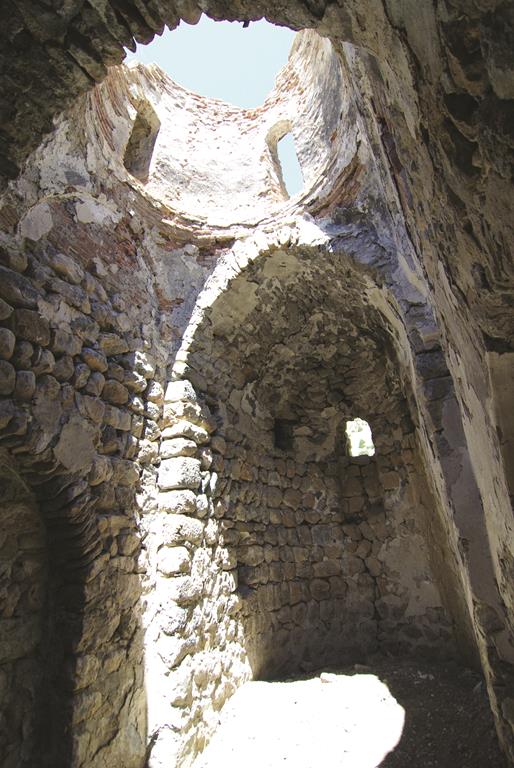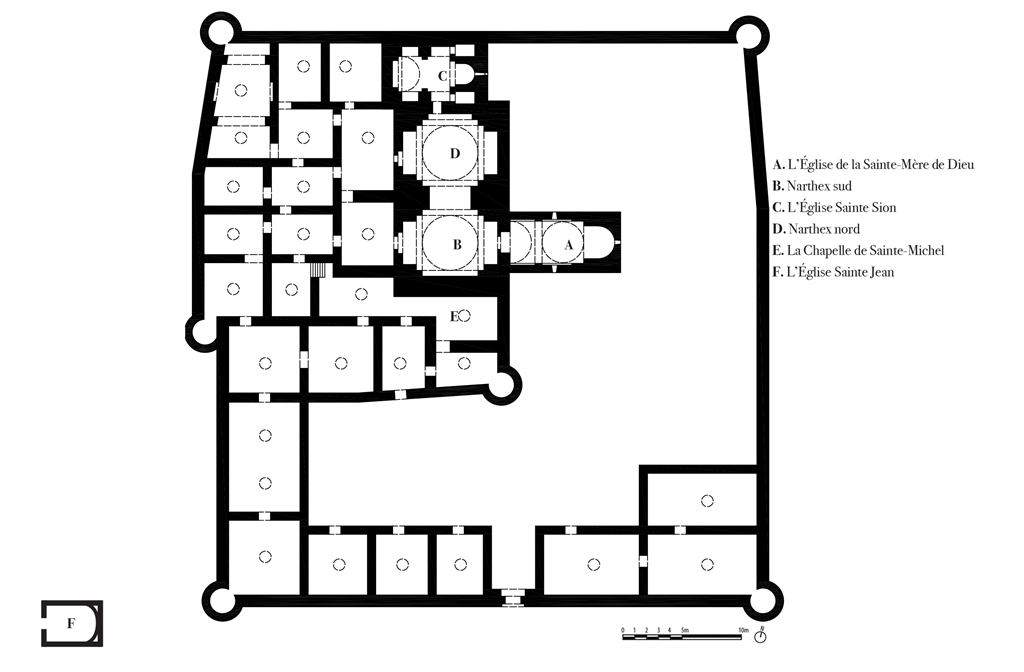This fortified convent is located east of Shadakh [Çatak], at an altitude of over 1900 m in the high eastern Tigris valley where the river flows into the K‘esrig or Gasrig river [Kırkgeçit] downstream from the village of the same name. This region makes up the Armenian canton of Antzevatsik‘, which is situated at the far eastern end of the Gortoug mountains. The convent lies to the south of mount d’Arnwassar‘ [***] and west of Akravouts K‘ar and Tarpnats K‘ar peaks at the foot of which stands the Gankwar [Örmeli] fortress.
A text from the turn of the 9th century relates the arrival in Armenia of the icon of the Virgin, which the apostles attending her death had entrusted to Saint Bartholomew. He in turn placed it not far from the Gankwar fortress in a chapel, which he dedicated to the Mother of God. Tradition links the founding of the convent of the Spirits to this episode, where, according to the Story of Hripsimé and the Holy Women (see n° 29), Hripsimé and her followers passed after having stopped at the site known as the Holy Lady (n° 32); it fell to Saint Gregory the Illuminator to organize the foundation into a proper convent, and tradition relates that it was initially for women; it is there that tradition also locates the tombs of King Tiridate IV (Dertad) and Queen Ashkhen, the first Christian monarchs, while a parallel tradition places them at the tomb of the Nine Saints of T‘ortan (n° 47). Catholicos Nerses I the Great (353-358, 363-373), of the Illuminator’s family (see n° 47, 52), installed a leper colony there. In 868, it was an established monastery, with Abbot Theodore (Teotoros) at its head. In the second half of the 11th century, the convent of the Spirits enjoyed such repute that Prince Philaretos (P‘ilardos Varajnouni) wanted its superior, John (Hovhannes), to sit as catholicos in his own States, which at that time extended from western Armenia to Cilicia.

L’Église de la Sainte-Mère de Dieu, bloc absidial et tambour, 2007 (Coll. privée)
The convent of the Spirits was home to Doctor Vartan, who in 1401 succeeded Sergius of Sorp (Sarkis Sorptsi, see n° 15, 28) at the University of Ardzwaper (n° 7). At that time the convent already had two churches: the Holy Mother of God and Holy Zion. It is attested as a scriptorium in 1490, 1557, 1666, 1670 and 1696, and apparently flourished in the 17th century, in particular under Archbishop Peter (Bedros), with whom the bey of Khoshab [Hoşap] attempted in 1651 to deposit the treasure stolen from Varak’s Holy Cross monastery (n° 1). In 1668 the convent of the Spirits was headed by Archbishop John (Hovhannes T‘ut‘unji), formerly patriarch of Constantinople (John V, 1663-1664, 1665-1667), who managed to gather under his own authority the three major monasteries of Varak, Salnabad and the convent of the Spirits, before becoming catholicos of Aght‘amar from 1669 to 1677 (John II) and then in 1678 undertaking a voyage to Ethiopia. The drum and the dome of the Mother of God church were restored in 1765, as were most of its fortifications. In the 19th century, the convent of the Spirits was the site of two pilgrimages, one on the feast of the Ascension and the other on that of the Holy Cross of Varak, but owing to its large landholdings, it was also the target of attacks. At the beginning of the 20th century, its priors undertook a new restoration campaign and opened the monastery to orphans.
The convent of the Spirits is composed of three main parts:
• A first set of gradually completed constructions forming a bloc with the two churches and delimited by an outer wall with towers at the four corners, of which the north and west panels still exist;
• Additions built out to the south and east, some of which abut the first complex, which they flank with a new southeastern tower, the others being built against a bigger courtyard wall with corners flanked with towers and built directly out from the first wall to the south and the east, enclosing the entire complex;
• A funeral church dedicated to Saint John erected outside the walls on the bank of the Tigris.
In particular, the convent includes:

General plan (Thierry d’après Cuneo, 1989, 454)
• The church of the Holy Mother of God (A), a single-vessel nave with a drum and pyramid and niches under arches, measuring some 9.9 × 4.3 m, probably dating from the 10th-11th centuries and remodeled; the drum and pyramid were restored in 1765 using stone from Shadakh – all of the blocks being held together with iron clamps set into lead plugs – and again in 1904;
• A narthex (B) with dome of around 6.7 m on a side on the interior, placed against the west wall of the church;
• A second, identical, narthex (D) set between the first, to the south, and the church of Holy Zion to the north;
• The church of Holy Zion (C), a tri-apsidial basilica measuring 8.2 × 5.4 m with a central horseshoe apse and deep niches under arches, open to the south, dated by some authors to the 5-6th centuries and by others to the 9-10th;
• The Archangel oratory (E), a small room to the south of the first narthex;
• A set of 25 dormered rooms linked by a labyrinth of passages and hallways to the narthex and the churches;
• A quadrangular courtyard measuring from 43 to 46 m on the sides with a wall 7 to 8 m high, open to the south and flanked with four corner towers and a fifth tower in the middle of the west wall, an old tower marking the southwest end of the primitive wall;
• The church of Saint John (F) outside the walls, a single-vessel nave covered with a pointed barrel vault;

Entrée de l'église vue depuis le narthex, 2007 (Coll. privée)
The convent possessed vast domains.
Confiscated after the Great War, the convent of the Spirits was left empty, being used most often to hold livestock. At the beginning of the 1970s, the buildings were still standing, although in several places the roofs already had holes or had collapsed, and different sections of the wall were eroded at the top or had fallen down, as was the case at the southeast corner. The dome of the Holy Mother of God had lost its coif, and the drum was missing most of its covering. Today, the whole complex is in extremely critical condition. Most of the western part of the wall has collapsed, while a huge opening has been made in the part still standing; similarly, on the south side, the section of wall to the left of the entrance has collapsed. Several of the rooms along the wall have also fallen in, as have the second narthex and the dome of the church of the Mother of God, where a few dressed stones still in place at the base of the drum give a vague idea of its shape. Saint John’s church is totally in ruins.
Oskian, 1940-1947, III [1947], 759-778. Cuneo, 1973, 32-33 et passim. Thierry, 1989, 452-457.